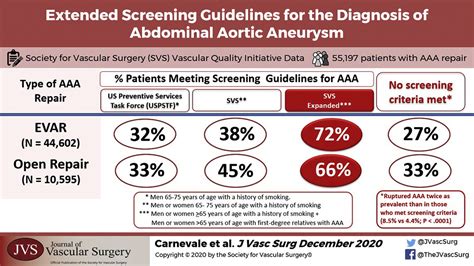Intro
Learn about AAA aortic aneurysm screening, including abdominal aorta ultrasound tests, risk factors, and prevention methods to detect and manage aortic disease, aneurysm repair, and cardiovascular health.
The importance of screening for medical conditions cannot be overstated, and one condition that warrants attention is the abdominal aortic aneurysm (AAA). An AAA is a bulge or swelling in the main blood vessel that leads from the heart and passes through the abdomen, which can be life-threatening if it ruptures. The risk factors for developing an AAA include age, smoking, high blood pressure, and family history, among others. Screening for AAA is a crucial step in identifying individuals who may be at risk and providing them with the necessary treatment to prevent a rupture.
Screening for AAA is particularly important for individuals who are at high risk of developing the condition. This includes men over the age of 65, smokers, and individuals with a family history of AAA. Women are also at risk, especially if they have a history of smoking or have a first-degree relative who has been diagnosed with an AAA. The screening process typically involves a simple ultrasound test that can detect the presence of an aneurysm. If an aneurysm is detected, further testing may be necessary to determine its size and the best course of treatment.
The benefits of AAA screening are numerous. Early detection and treatment can significantly reduce the risk of rupture, which can be fatal. In fact, studies have shown that screening for AAA can reduce the risk of death from a ruptured aneurysm by up to 50%. Additionally, screening can provide individuals with peace of mind, knowing that they have taken proactive steps to protect their health. Furthermore, early detection and treatment can also reduce the risk of complications associated with AAA, such as blood clots and kidney damage.
Aortic Aneurysm Screening Process

The screening process for AAA typically involves a series of steps. The first step is to determine if an individual is at risk of developing an AAA. This involves assessing their medical history, including their age, smoking status, and family history. If an individual is deemed to be at risk, they will be referred for an ultrasound test. The ultrasound test is a non-invasive and painless procedure that uses high-frequency sound waves to create images of the aorta. The test can detect the presence of an aneurysm and measure its size.
Ultrasound Test for AAA Screening
The ultrasound test is the primary method used for AAA screening. The test is typically performed in a hospital or clinic and takes around 30 minutes to complete. During the test, a technician will apply a gel to the abdomen and use a probe to send high-frequency sound waves through the skin. The sound waves will bounce off the aorta and create images that can be viewed on a screen. The technician will measure the diameter of the aorta and check for any signs of an aneurysm.Risk Factors for Abdominal Aortic Aneurysm

There are several risk factors that can increase an individual's likelihood of developing an AAA. These include:
- Age: Men over the age of 65 are at higher risk of developing an AAA.
- Smoking: Smoking is a significant risk factor for AAA, and individuals who smoke are up to 10 times more likely to develop the condition.
- Family history: Individuals with a first-degree relative who has been diagnosed with an AAA are at higher risk of developing the condition.
- High blood pressure: High blood pressure can increase the risk of developing an AAA.
- High cholesterol: High levels of low-density lipoprotein (LDL) cholesterol can increase the risk of developing an AAA.
Treatment Options for AAA
If an aneurysm is detected during the screening process, further testing may be necessary to determine the best course of treatment. The treatment options for AAA depend on the size of the aneurysm and the individual's overall health. Small aneurysms may not require immediate treatment, but regular monitoring to check for any changes in size. Larger aneurysms may require surgery to repair or replace the affected section of the aorta.Benefits of Early Detection and Treatment

The benefits of early detection and treatment of AAA are numerous. Early detection can significantly reduce the risk of rupture, which can be fatal. In fact, studies have shown that screening for AAA can reduce the risk of death from a ruptured aneurysm by up to 50%. Additionally, early detection and treatment can also reduce the risk of complications associated with AAA, such as blood clots and kidney damage.
Reducing the Risk of AAA
There are several steps that individuals can take to reduce their risk of developing an AAA. These include: * Quitting smoking: Smoking is a significant risk factor for AAA, and quitting can significantly reduce the risk of developing the condition. * Maintaining a healthy weight: Being overweight or obese can increase the risk of developing an AAA. * Exercising regularly: Regular exercise can help to reduce the risk of developing an AAA. * Eating a healthy diet: Eating a diet that is low in saturated fat and high in fruits and vegetables can help to reduce the risk of developing an AAA.Current Research and Developments

There are several current research and developments in the field of AAA screening and treatment. These include the development of new imaging technologies, such as magnetic resonance imaging (MRI) and computed tomography (CT) scans, which can provide more detailed images of the aorta. Additionally, researchers are working to develop new treatments for AAA, such as endovascular repair, which involves using a minimally invasive procedure to repair the aneurysm.
Future Directions for AAA Screening
The future of AAA screening looks promising, with several new technologies and treatments being developed. One area of research is the use of artificial intelligence (AI) to improve the accuracy of AAA screening. AI algorithms can be used to analyze images of the aorta and detect any signs of an aneurysm. Additionally, researchers are working to develop new biomarkers that can be used to detect AAA at an early stage.Conclusion and Final Thoughts

In conclusion, AAA screening is a crucial step in identifying individuals who may be at risk of developing an abdominal aortic aneurysm. The benefits of early detection and treatment are numerous, and can significantly reduce the risk of rupture and death. By understanding the risk factors for AAA and taking steps to reduce them, individuals can protect their health and well-being. As research and developments continue to advance, the future of AAA screening looks promising, with new technologies and treatments being developed to improve detection and treatment.
We invite you to share your thoughts and questions about AAA screening in the comments below. If you have any experience with AAA screening or treatment, we would love to hear about it. Additionally, if you have any questions or concerns about AAA screening, please don't hesitate to ask.
What is an abdominal aortic aneurysm?
+An abdominal aortic aneurysm is a bulge or swelling in the main blood vessel that leads from the heart and passes through the abdomen.
What are the risk factors for developing an AAA?
+The risk factors for developing an AAA include age, smoking, high blood pressure, and family history, among others.
How is AAA screening performed?
+AAA screening is typically performed using an ultrasound test, which is a non-invasive and painless procedure that uses high-frequency sound waves to create images of the aorta.
What are the benefits of early detection and treatment of AAA?
+The benefits of early detection and treatment of AAA include reducing the risk of rupture and death, as well as reducing the risk of complications associated with AAA.
Can AAA be prevented?
+While AAA cannot be completely prevented, there are several steps that individuals can take to reduce their risk of developing the condition, such as quitting smoking, maintaining a healthy weight, exercising regularly, and eating a healthy diet.
